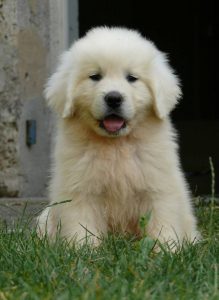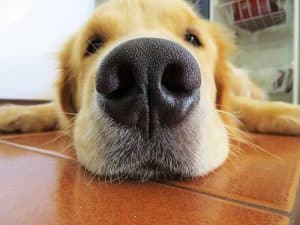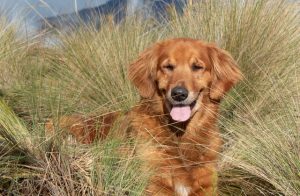There are lots of things that you need to do when you first get a puppy feed them a healthy diet, play with them, groom them, potty train them, and train them! Training can be one of the most rewarding puppy pursuits. Training opens up the lines of communication, which in turn helps the two of you develop a firm bond. It’s hard to have a relationship without training.
There are so many different fun ings that you can train your puppy to do but what should you start with? Should you start with sit? Come? Play dead? Which are the most critical? Well, that is what we are going to cover in this article!
First of all, it is important to note that training can be started as soon as you bring your pup home. You are not going to “break your dog’s spirit” by training “too soon.” Indeed, as long as you use positive reinforcement you need to start training as soon as you bring your pup home!
Things That Your Pup Needs To Learn That Aren’t Nessicaraly Put To A Cue
Some things that your puppy will need to learn are not the fun tricks or obedience commands, but rather things that will make your life together easier. These things don’t always have a cue. Some of these things may seem acceptable as a puppy, but remember your puppy will one day be a strong adult dog.
One of these is potty training. You defiantly want to train your pup to potty outside and this should start as soon as you bring him home! Be sure to praise your pup and give him treats for potting in the right place. Also, remember that the fewer accidents he has the less likely he is to have one.
You are also going to want to work on bite-inhibition right away. This is where you allow your puppy to chew on you but only if it isn’t too hard. Slowly you teach your puppy that less and less pressure bites will cause you to “yelp!” This will help your pup to not only learn not to bite but that even the slightest bite can hurt a human and hurting is not what your pup wants to do.
Teaching your puppy to chew on the appropriate things is also an important part of creating a healthy relationship with your new puppy. Always provide your puppy with a variety of healthy things to chew on like raw bones, bully sticks, tracheas, and the like. If you find your puppy chewing on something that you do not want him to chew on, redirect him to chew on something that is appropriate. Stay with him and praise him for chewing on the right item. Always praise your puppy when he is chewing appropriately.
Right off the bat you also want to make it clear to your puppy that he must share all things with you. Nothing is his, he should not “protect” anything form you. So, when you give your puppy a chew practice trading him for it. Offer him a toy or supper yummy treat and take the chew that he has. As soon as he has eaten the treat or played with the toy give back the original item. Also, when he is eating be sure to be near his food bowl and drop a few treats in his bowl whenever you get close. This will teach the puppy that good things happen when you are close to his food bowl!
You will also want to help your puppy feel okay when he is alone. If you have a job that you can’t bring your puppy to or you need to go to the grocery store he needs to know that he can be alone. Work on this gradually, leaving him with a stuffed Kong for only a few seconds at a time. Slowly work to a few minutes, half an hour, an hour, etc. Always return to your puppy before he starts to whine or cry for you. If you reappear while your puppy is calling for you then you will teach him that his crying will bring you back, which is not what you want to train!
It is helpful to establish daily routines as soon as you bring your puppy home. Be consistent with his schedule. This will help him to feel stable. Stability always helps to create a more confident puppy. Schedule potty breaks, feedings, playtime, grooming sessions, walkies, and more.
Socialization is a thing that should have been started at the breed and will need to continue with you. Expose your puppy to as much variety of positive experiences as possible. Get his used to all sorts of people, places, animals, sounds, smells, sights, traveling in the car, and anything else you can think of. Be sure to keep experiences happy and positive.
It is also a great idea to start with door manners as soon as you start using the door. Door manners include things like having your dog wait, stay, or sit when you open a door. Sitting when you open the door to let someone in is also an excellent door manner to teach. Additionally, now is the time to let your dog know that he should not jump on guests and won’t get any attention for that. Rather he needs to sit quietly to get attention from the guest.
One more thing that can be helpful is to teach your puppy to calm down. This works best if you have a mat or towel or small blanket. You will want to teach your puppy to go to the mat, lay on it, and chill out there. This is mainly done by giving your puppy lots of treats for staying on the mat. One treat at a time, eventually, he will realize that the treats are all happening on the mat and nothing else is really as interesting as staying on the mat. This can be a handy thing to have up your sleeve if you have company over or when you take your puppy to the vet or anywhere else with you and you just want him to be calm.
More Traditional Things To Be Trained
Other things that should be taught are things that are more traditionally thought of as training. This includes introducing your puppy to the clicker. If you intend to use the clicker for training, training your puppy that a click means he did something right and a treat is coming is a great first thing to teach. This will give you a foundation of consistent communication that can put your puppy on the fast track to training success.
The next thing that you will want to teach your puppy is his name. This is a great way to get his attention. You want your puppy to have a positive association with his name. So, say his name and when he looks at you, give him a treat. Pretty soon all you will have to do is say his name and he will be right there staring up at you. Be sure not to poison his name by calling his name only when he is in trouble or overusing his name so that it no longer means anything.
Your puppy may naturally start to come to you when you say his name and that’s great! But it is also a good idea to create an actual cue to get him to come to you. You can say his name and then say “come.” If he does not immediately come to you, try running away from him. Most puppies love chasing things so they will follow after you! When the pup catches up, give him a treat. Eventually, you will not need to run away, just call him to come.
Teaching your puppy to touch his nose to your hand is a seemingly insignificant trick. However, it can be an awesome way to get your dog’s attention, distract him, and tire him out. Present your puppy with your open hand, he will likely come to investigate. When he touches his nose to your hand click and treat. You can use this if your puppy is scared, in a strange environment, driving other people crazy, has too much energy, or just for fun.
Loose leash walking should be started the second you put the leash on your puppy. If he is never allowed to pull on the leash, he never will. With the leash attached, only walk with your puppy if the leash is slack. If it goes taut, at all, stop. The puppy will learn that there must be slack on the leash in order for him to get to go anywhere. It is also a great idea of praise your puppy when there is slack on the leash. Be sure to always walk your puppy with his leash attached to a harness instead of a collar.
Sit and laydown are also helpful things to teach your puppy. These can be good things to teach your puppy to stop and be calm. Or to stop in his tracks of whatever he is doing. If you teach your dog to sit or laydown you can use it to prevent him from getting into trouble. For instance, he cannot jump on the guests, jump on the counter, or run in circles around your toddler if he is sitting or laying down.
Stay or wait can be helpful as well. Teaching your puppy to stay in one place or in an area on your command is very helpful. If you are cooking in the kitchen or have the front door open to grab a package, having your puppy stay or wait is way better than having to try and corral the pup and then do your task. As with all training, you will start small and work slowly with stay and wait training.
It is a great idea to enroll your puppy in puppy training classes. This will help your puppy learn the basics with lots of distractions and offer some socialization opportunities. Puppy classes can be a great way to make new friends and really solidify your training. If you want to be an overachiever train your puppy to do all the things that he will learn in the class before the class starts!
Summary
Puppy training is fun and rewarding! If you only teach the above things you are doing well. But once you get bitten by the training bug you may go on to more training. Perhaps you and your puppy will love training so much that you will enter formal obedience training, go into dog agility, canine freestyle, treibball, or some other super fun canine sport.






Leave a Reply
You must be logged in to post a comment.